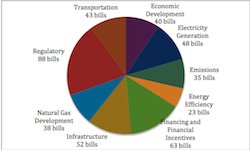Researchers might have found a more efficient way to turn biomass into biofuel using plant genetics. This article from Phys.org says plant geneticists Sam Hazen at the University of Massachusetts Amherst and Siobhan Brady at the University of California, Davis, have sorted out the gene regulatory networks that would have the biggest impacts on the green fuel production.
The authors say that the most rigid of the polymers, lignin, represents “a major impediment” to extracting sugars from plant biomass that can be used to make biofuels. Their genetic advance is expected to “serve as a foundation for understanding the regulation of a complex, integral plant component” and as a map for how future researchers might manipulate the polymer-forming processes to improve the efficiency of biofuel production.
The three key components, found in plant tissues known as xylem, provide plants with mechanical strength and waterproof cells that transport water. Working in the model plant Arabidopsis thaliana, Hazen, Brady and colleagues explored how a large number of interconnected transcription factors regulate xylem and cell wall thickening. Results appeared in an early online edition Dec. 24 in Nature.
An invited commentary in the journal on the significance of this discovery points out that “understanding how the relative proportions of these biopolymers are controlled in plant tissue would open up opportunities to redesign plants for biofuel use.” Hazen, Brady and colleagues’ study identified hundreds of new regulators and offers “considerable insight,” the authors say, “into the developmental regulation of xylem cell differentiation.”
The authors of the study were able to find that most of the proteins including regulators of cell cycle and differentiation bind directly to cellulose genes and to other transcription regulators, giving plants a huge number of possible combinations for responding and adapting to environmental stressors.








